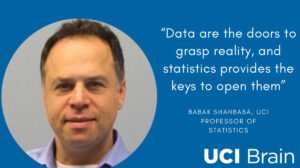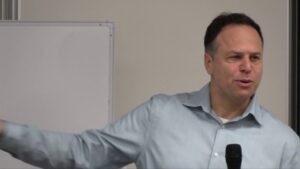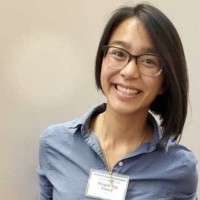Researcher Spotlight: Dr. Babak Shahbaba

Statistics: A Collaborative Tool, Not a Dreaded Obstacle
By Abigail Y. Flores
Using statistical methods is a common discomfort for most graduate students. However, for Dr. Babak Shahbaba, a professor of statistics, utilizing nonparametric Bayesian methods is his passion.
At his office in the Donald Bren School of Information and Computer Sciences, I ask Dr. Shahbaba how he began his collaboration with Dr. Norbert Fortin, Associate Professor of Neurobiology and Behavior (NBB). As a first year graduate student, I was fortunate to rotate with Dr. Fortin, and heard of Dr. Shahbab in many of the Fortin lab meetings. Dr. Shahbab credits Dr. Robert Kass, Professor of Statistics and Computational Neuroscience from Carnegie Mellon University, who knew Dr. Fortin’s work and encouraged Dr. Shahbaba to collaborate. Funnily enough, upon meeting each other, Dr. Shahbaba recognized Dr. Fortin as a fellow school parent – both of their sons are classmates. “That started a friendship and a collaboration, which to me is the best type of collaboration,” one in which you can have “mutual respect and appreciate each person’s dedication to solving scientific problems,” says Dr. Shahbaba. In two and a half years, this collaboration led to an R01 grant and multiple published papers. Yet, Dr. Shahbaba is concerned that such a fruitful collaboration began serendipitously: “There needs to be a better mechanism to match collaborators with each other.” Together Dr. Fortin and Dr. Shahbaba are working on training grants that aim to foster collaborations between neuroscientists and statisticians more systematically. “Neuroscientists can find the statistical methods to answer their scientific hypotheses, and statisticians can find inspiration from these hypotheses to develop new methodologies,” remarks Dr. Shahbaba. Dr. Shahbaba hopes these training grants will instill in graduate students the “interdisciplinary skills which can’t be taught in class.” “Collaborative projects are becoming more and more common, because the nature of these applied programs requires a diverse group of scientists with complimentary backgrounds to solve it,” summarizes Dr. Shahbaba. Yet as the Director of the Data Science Institute (which combines statistics, computer science, and applied mathematics), Dr. Shahbaba isn’t just waiting for these grants: he is creating short summer courses in data science and exploring how to extend a concurrent Masters of Statistics to interested neurobiology graduate students.
 With a smile, Dr. Shahbaba says that he wants to lessen the fear hovering over statistics and shares how he became a professor. It required two transitions: from engineering to statistics, and from industry to academia. Dr. Shahbaba admits that his affinity and aptitude for mathematics originally guided his choice to become an engineer, as he “liked the application of math to real problems.” Over time, however, he became more interested in statistics, because it “has a unique role in connecting math to so many fields, such as biology, engineering, social sciences, and medical sciences.” Dr. Shahbaba found his home at UCI’s department of Statistics, which “was built to develop methodologies to solve applied problems and then create theories that would justify those methodologies. At our department’s core, we want to be inspired by applied problems.” Although he had tackled such problems in industry, Dr. Shahbaba realized that academia combined his passion for research with the drive to mentor and train students. “It’s important that you solve scientific problems, but you have to train the next generation because you alone do not have all the expertise nor time to solve every problem. This is how progress happens: the next generation needs to be better than the current. It is a necessity,” remarks Dr. Shahbaba.
With a smile, Dr. Shahbaba says that he wants to lessen the fear hovering over statistics and shares how he became a professor. It required two transitions: from engineering to statistics, and from industry to academia. Dr. Shahbaba admits that his affinity and aptitude for mathematics originally guided his choice to become an engineer, as he “liked the application of math to real problems.” Over time, however, he became more interested in statistics, because it “has a unique role in connecting math to so many fields, such as biology, engineering, social sciences, and medical sciences.” Dr. Shahbaba found his home at UCI’s department of Statistics, which “was built to develop methodologies to solve applied problems and then create theories that would justify those methodologies. At our department’s core, we want to be inspired by applied problems.” Although he had tackled such problems in industry, Dr. Shahbaba realized that academia combined his passion for research with the drive to mentor and train students. “It’s important that you solve scientific problems, but you have to train the next generation because you alone do not have all the expertise nor time to solve every problem. This is how progress happens: the next generation needs to be better than the current. It is a necessity,” remarks Dr. Shahbaba.
Yet to be successful, Dr. Shahbaba believes that “you must work hard, but how you do it must be sustainable. You must make the time you work productive.” For Dr. Shahbaba, this means setting time aside from conducting his own research, mentoring his students, and spending time with his family, for activities that allow him to “detach.” These activities include watching National Football League (NFL) “to learn the strategies,” cooking, and performing yoga “which combines meditation and exercise.”
Dr. Babak Shahbaba is an avid statistician, a nurturing mentor to his students, and an advocate for empowering graduate students to engage in interdisciplinary collaborations. Despite my initial hesitations, I now look forward to taking statistics and data science courses after interviewing Dr. Babak Shahbaba.
To learn more about his work, discover opportunities to take data science courses, begin a collaboration, or to simply meet with Dr. Babak Shahbaba, please contact him through his UCI email.

About Abigail Y. Flores
Aby is a PhD student and member of the communications committee in the Center for the Neurobiology of Learning and Memory Ambassadors program. She earned her dual B.S in Biology and Neuroscience from the University of Florida. As a first year graduate student in the Interdepartmental Neuroscience Program (INP), she is interested in learning, memory, decision-making, and addiction.
